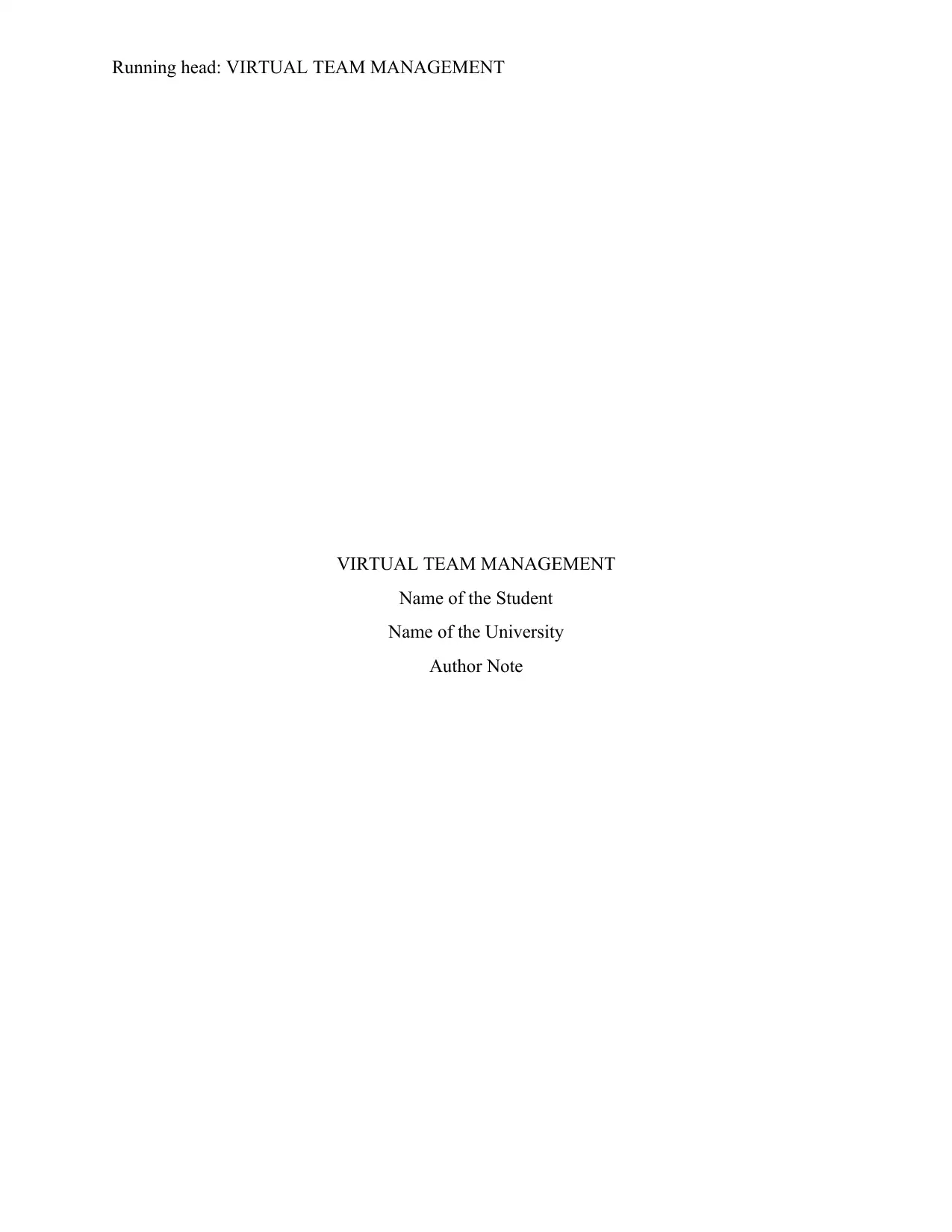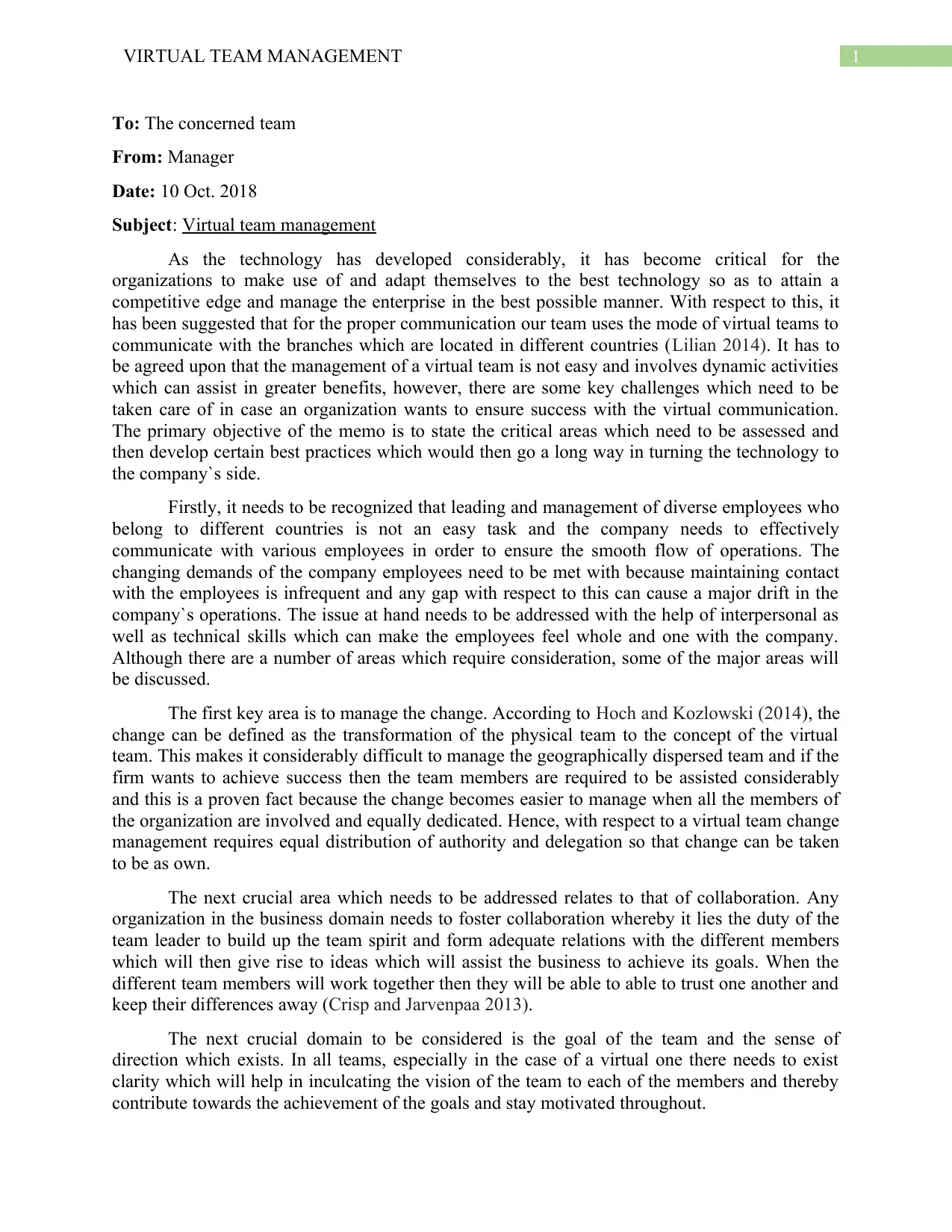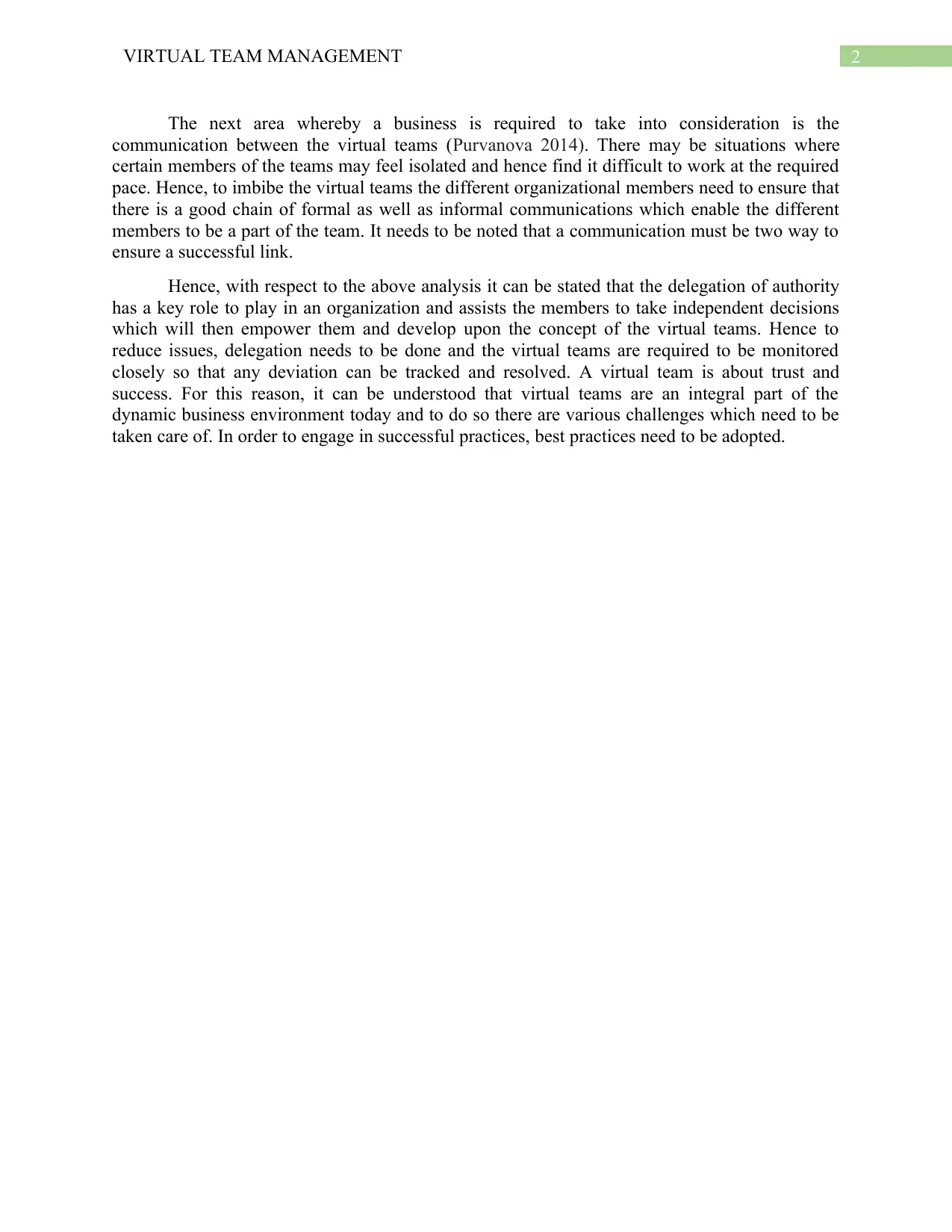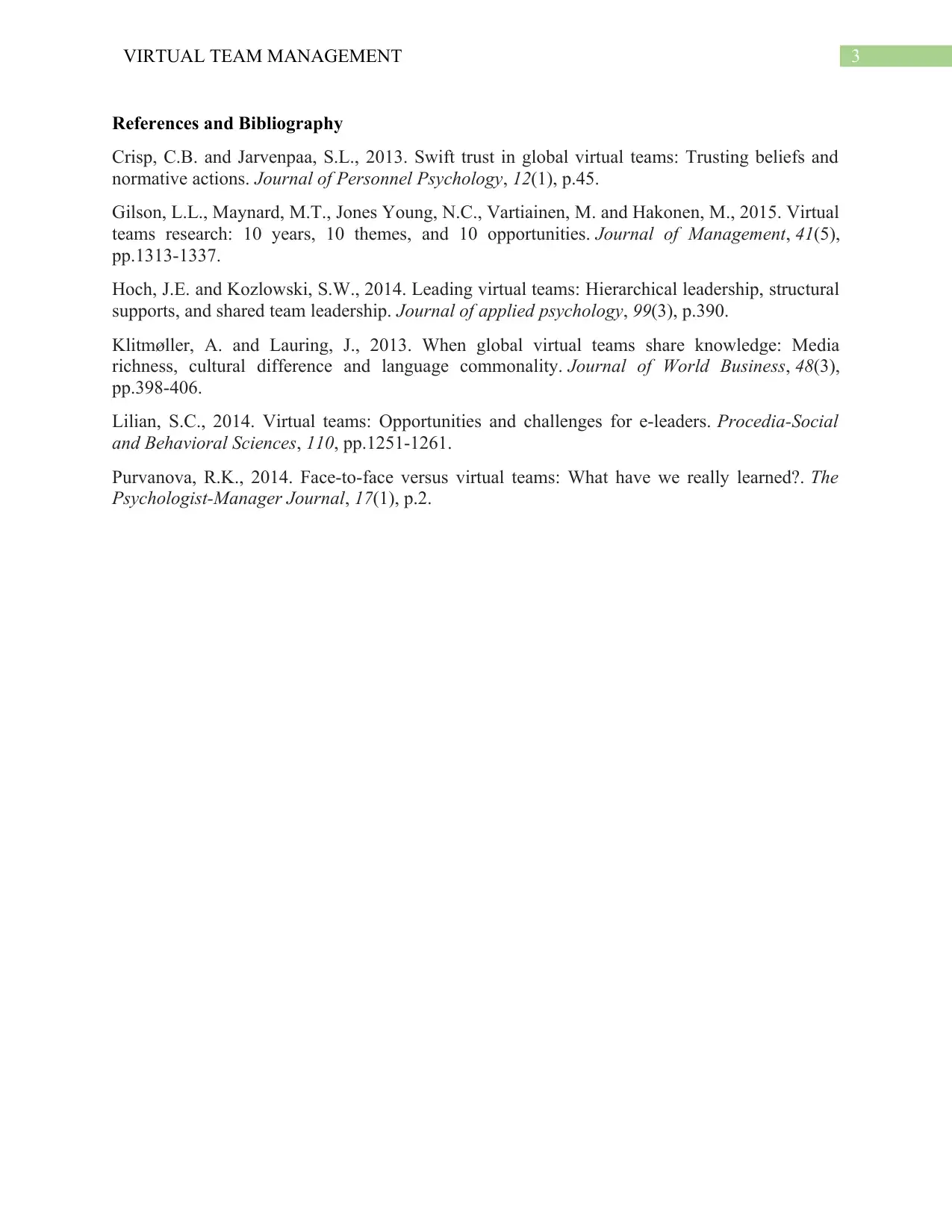Virtual Team Management: Critical Areas, Challenges & Best Practices
VerifiedAdded on 2023/06/03
|4
|1106
|172
Report
AI Summary
This report discusses the critical aspects of virtual team management, emphasizing the importance of adapting to technological advancements for maintaining a competitive edge. It highlights key challenges such as managing diverse employees across different locations, addressing changing employee demands, and fostering effective communication. The report identifies crucial areas including change management, collaboration, team goals, and communication strategies. It suggests that delegation of authority, trust-building, and close monitoring are essential for successful virtual team management. Ultimately, the report underscores the integral role of virtual teams in today's dynamic business environment and the need for adopting best practices to overcome associated challenges, enabling team empowerment and independent decision-making.

Running head: VIRTUAL TEAM MANAGEMENT
VIRTUAL TEAM MANAGEMENT
Name of the Student
Name of the University
Author Note
VIRTUAL TEAM MANAGEMENT
Name of the Student
Name of the University
Author Note
Paraphrase This Document
Need a fresh take? Get an instant paraphrase of this document with our AI Paraphraser

1VIRTUAL TEAM MANAGEMENT
To: The concerned team
From: Manager
Date: 10 Oct. 2018
Subject: Virtual team management
As the technology has developed considerably, it has become critical for the
organizations to make use of and adapt themselves to the best technology so as to attain a
competitive edge and manage the enterprise in the best possible manner. With respect to this, it
has been suggested that for the proper communication our team uses the mode of virtual teams to
communicate with the branches which are located in different countries (Lilian 2014). It has to
be agreed upon that the management of a virtual team is not easy and involves dynamic activities
which can assist in greater benefits, however, there are some key challenges which need to be
taken care of in case an organization wants to ensure success with the virtual communication.
The primary objective of the memo is to state the critical areas which need to be assessed and
then develop certain best practices which would then go a long way in turning the technology to
the company`s side.
Firstly, it needs to be recognized that leading and management of diverse employees who
belong to different countries is not an easy task and the company needs to effectively
communicate with various employees in order to ensure the smooth flow of operations. The
changing demands of the company employees need to be met with because maintaining contact
with the employees is infrequent and any gap with respect to this can cause a major drift in the
company`s operations. The issue at hand needs to be addressed with the help of interpersonal as
well as technical skills which can make the employees feel whole and one with the company.
Although there are a number of areas which require consideration, some of the major areas will
be discussed.
The first key area is to manage the change. According to Hoch and Kozlowski (2014), the
change can be defined as the transformation of the physical team to the concept of the virtual
team. This makes it considerably difficult to manage the geographically dispersed team and if the
firm wants to achieve success then the team members are required to be assisted considerably
and this is a proven fact because the change becomes easier to manage when all the members of
the organization are involved and equally dedicated. Hence, with respect to a virtual team change
management requires equal distribution of authority and delegation so that change can be taken
to be as own.
The next crucial area which needs to be addressed relates to that of collaboration. Any
organization in the business domain needs to foster collaboration whereby it lies the duty of the
team leader to build up the team spirit and form adequate relations with the different members
which will then give rise to ideas which will assist the business to achieve its goals. When the
different team members will work together then they will be able to able to trust one another and
keep their differences away (Crisp and Jarvenpaa 2013).
The next crucial domain to be considered is the goal of the team and the sense of
direction which exists. In all teams, especially in the case of a virtual one there needs to exist
clarity which will help in inculcating the vision of the team to each of the members and thereby
contribute towards the achievement of the goals and stay motivated throughout.
To: The concerned team
From: Manager
Date: 10 Oct. 2018
Subject: Virtual team management
As the technology has developed considerably, it has become critical for the
organizations to make use of and adapt themselves to the best technology so as to attain a
competitive edge and manage the enterprise in the best possible manner. With respect to this, it
has been suggested that for the proper communication our team uses the mode of virtual teams to
communicate with the branches which are located in different countries (Lilian 2014). It has to
be agreed upon that the management of a virtual team is not easy and involves dynamic activities
which can assist in greater benefits, however, there are some key challenges which need to be
taken care of in case an organization wants to ensure success with the virtual communication.
The primary objective of the memo is to state the critical areas which need to be assessed and
then develop certain best practices which would then go a long way in turning the technology to
the company`s side.
Firstly, it needs to be recognized that leading and management of diverse employees who
belong to different countries is not an easy task and the company needs to effectively
communicate with various employees in order to ensure the smooth flow of operations. The
changing demands of the company employees need to be met with because maintaining contact
with the employees is infrequent and any gap with respect to this can cause a major drift in the
company`s operations. The issue at hand needs to be addressed with the help of interpersonal as
well as technical skills which can make the employees feel whole and one with the company.
Although there are a number of areas which require consideration, some of the major areas will
be discussed.
The first key area is to manage the change. According to Hoch and Kozlowski (2014), the
change can be defined as the transformation of the physical team to the concept of the virtual
team. This makes it considerably difficult to manage the geographically dispersed team and if the
firm wants to achieve success then the team members are required to be assisted considerably
and this is a proven fact because the change becomes easier to manage when all the members of
the organization are involved and equally dedicated. Hence, with respect to a virtual team change
management requires equal distribution of authority and delegation so that change can be taken
to be as own.
The next crucial area which needs to be addressed relates to that of collaboration. Any
organization in the business domain needs to foster collaboration whereby it lies the duty of the
team leader to build up the team spirit and form adequate relations with the different members
which will then give rise to ideas which will assist the business to achieve its goals. When the
different team members will work together then they will be able to able to trust one another and
keep their differences away (Crisp and Jarvenpaa 2013).
The next crucial domain to be considered is the goal of the team and the sense of
direction which exists. In all teams, especially in the case of a virtual one there needs to exist
clarity which will help in inculcating the vision of the team to each of the members and thereby
contribute towards the achievement of the goals and stay motivated throughout.

2VIRTUAL TEAM MANAGEMENT
The next area whereby a business is required to take into consideration is the
communication between the virtual teams (Purvanova 2014). There may be situations where
certain members of the teams may feel isolated and hence find it difficult to work at the required
pace. Hence, to imbibe the virtual teams the different organizational members need to ensure that
there is a good chain of formal as well as informal communications which enable the different
members to be a part of the team. It needs to be noted that a communication must be two way to
ensure a successful link.
Hence, with respect to the above analysis it can be stated that the delegation of authority
has a key role to play in an organization and assists the members to take independent decisions
which will then empower them and develop upon the concept of the virtual teams. Hence to
reduce issues, delegation needs to be done and the virtual teams are required to be monitored
closely so that any deviation can be tracked and resolved. A virtual team is about trust and
success. For this reason, it can be understood that virtual teams are an integral part of the
dynamic business environment today and to do so there are various challenges which need to be
taken care of. In order to engage in successful practices, best practices need to be adopted.
The next area whereby a business is required to take into consideration is the
communication between the virtual teams (Purvanova 2014). There may be situations where
certain members of the teams may feel isolated and hence find it difficult to work at the required
pace. Hence, to imbibe the virtual teams the different organizational members need to ensure that
there is a good chain of formal as well as informal communications which enable the different
members to be a part of the team. It needs to be noted that a communication must be two way to
ensure a successful link.
Hence, with respect to the above analysis it can be stated that the delegation of authority
has a key role to play in an organization and assists the members to take independent decisions
which will then empower them and develop upon the concept of the virtual teams. Hence to
reduce issues, delegation needs to be done and the virtual teams are required to be monitored
closely so that any deviation can be tracked and resolved. A virtual team is about trust and
success. For this reason, it can be understood that virtual teams are an integral part of the
dynamic business environment today and to do so there are various challenges which need to be
taken care of. In order to engage in successful practices, best practices need to be adopted.
⊘ This is a preview!⊘
Do you want full access?
Subscribe today to unlock all pages.

Trusted by 1+ million students worldwide

3VIRTUAL TEAM MANAGEMENT
References and Bibliography
Crisp, C.B. and Jarvenpaa, S.L., 2013. Swift trust in global virtual teams: Trusting beliefs and
normative actions. Journal of Personnel Psychology, 12(1), p.45.
Gilson, L.L., Maynard, M.T., Jones Young, N.C., Vartiainen, M. and Hakonen, M., 2015. Virtual
teams research: 10 years, 10 themes, and 10 opportunities. Journal of Management, 41(5),
pp.1313-1337.
Hoch, J.E. and Kozlowski, S.W., 2014. Leading virtual teams: Hierarchical leadership, structural
supports, and shared team leadership. Journal of applied psychology, 99(3), p.390.
Klitmøller, A. and Lauring, J., 2013. When global virtual teams share knowledge: Media
richness, cultural difference and language commonality. Journal of World Business, 48(3),
pp.398-406.
Lilian, S.C., 2014. Virtual teams: Opportunities and challenges for e-leaders. Procedia-Social
and Behavioral Sciences, 110, pp.1251-1261.
Purvanova, R.K., 2014. Face-to-face versus virtual teams: What have we really learned?. The
Psychologist-Manager Journal, 17(1), p.2.
References and Bibliography
Crisp, C.B. and Jarvenpaa, S.L., 2013. Swift trust in global virtual teams: Trusting beliefs and
normative actions. Journal of Personnel Psychology, 12(1), p.45.
Gilson, L.L., Maynard, M.T., Jones Young, N.C., Vartiainen, M. and Hakonen, M., 2015. Virtual
teams research: 10 years, 10 themes, and 10 opportunities. Journal of Management, 41(5),
pp.1313-1337.
Hoch, J.E. and Kozlowski, S.W., 2014. Leading virtual teams: Hierarchical leadership, structural
supports, and shared team leadership. Journal of applied psychology, 99(3), p.390.
Klitmøller, A. and Lauring, J., 2013. When global virtual teams share knowledge: Media
richness, cultural difference and language commonality. Journal of World Business, 48(3),
pp.398-406.
Lilian, S.C., 2014. Virtual teams: Opportunities and challenges for e-leaders. Procedia-Social
and Behavioral Sciences, 110, pp.1251-1261.
Purvanova, R.K., 2014. Face-to-face versus virtual teams: What have we really learned?. The
Psychologist-Manager Journal, 17(1), p.2.
1 out of 4
Related Documents
Your All-in-One AI-Powered Toolkit for Academic Success.
+13062052269
info@desklib.com
Available 24*7 on WhatsApp / Email
![[object Object]](/_next/static/media/star-bottom.7253800d.svg)
Unlock your academic potential
Copyright © 2020–2025 A2Z Services. All Rights Reserved. Developed and managed by ZUCOL.




